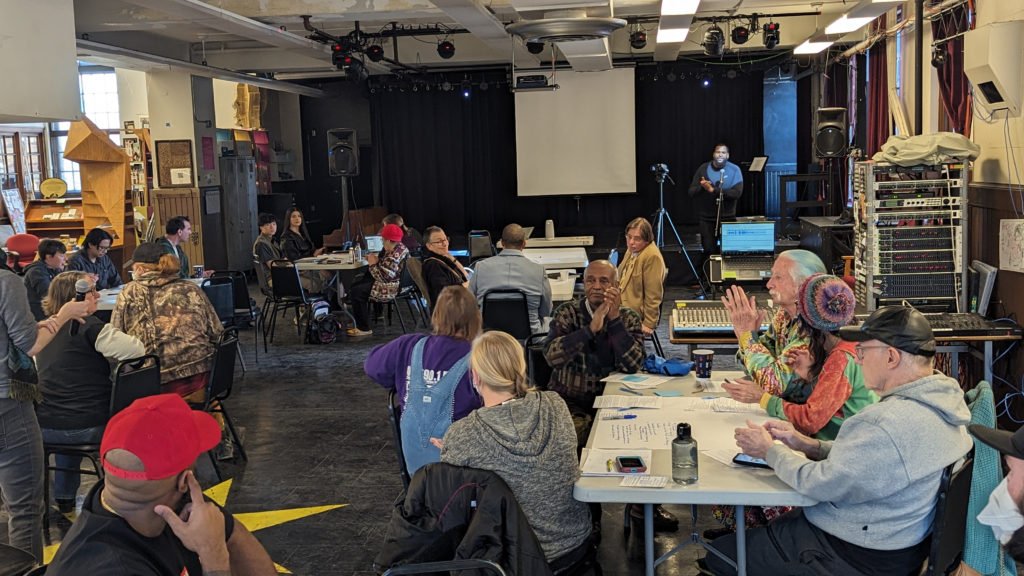
UCIMC’s second public safety forum on March 24. Photo by Prasad Packirisamy, used with permission
On March 24, the UCIMC hosted a second public safety forum focused on alternative responses to traditional law enforcement. The forum was organized in accordance with calls from Urbana residents and elected officials for a study of alternatives to traditional policing in the wake of George Floyd’s murder in the summer of 2020 and a violent skirmish between a young, unarmed Black woman and police in Urbana in 2021.
Urbana City Council members Jaya Kolisety and Chaundra Bishop responded to those calls by requesting a study of alternative response options. The city commissioned BerryDunn, a “full-service accounting, assurance, and consulting firm,” according to their website, to undertake the study. Its scope was also expanded by city staff to include a Public Safety Operational Review and Assessment. BerryDunn is releasing the report in four phases, with the operational review and assessment being Phase 1, and the subsequent phases considering alternatives, as requested. The Phase 1 report was released just before the IMC event and recommended that Urbana add an unprecedented 14 more traditional law enforcement officers. This came as a shock to many local residents who expected that investments would be focused on alternatives, or at least that recommendations on staffing would not be considered until the study of alternatives had been completed and released.

Local schools spend hundreds of thousands of dollars a year leasing metal detectors, like this unit at Urbana Middle School, but balk at funding additional counselors
These concerns and questions made the UCIMC forum especially timely. A presentation was given by Law Enforcement Action Partnership (LEAP). As described on the organization’s website, “LEAP speakers—all of whom have worked in law enforcement—write, consult, and meet with advocacy groups, legislators, fellow officers, the media, and the public to craft and support policies that make our communities safer and more just.” The speakers focused on lessons learned and recommendations from their extensive experience with supporting, studying, and designing alternative response models in cities across the country. Additionally, LEAP speakers were able to briefly review the recommendations presented in the Phase 1 BerryDunn report and give community members and elected leaders insight on where their recommendations differed.
LEAP’s presentation (available along with audio and video of the event at ucimc.org/csr) focused on the logistics of alternative response efforts, the kinds of calls they frequently respond to, safety of responders, where these programs are housed, and how they are funded. Using Rochester, NY as an example, LEAP shared that nearly half of Rochester’s 911 calls were for conflict resolution, behavioral health, and suspicious person concerns—all types of calls LEAP suggested were best served by alternative responders. LEAP presenters pointed out that this was where their recommendations differed from the Phase 1 BerryDunn findings, which called for an unprecedented increase in traditional law enforcement officers and “Community Service Responders” within the Urbana Police Department who would only respond to low-level criminal calls (such as traffic tickets and noise complaints), to free up uniformed officer time and reduce costs. The potential to free up officer time by diverting non-criminal calls is much higher, however. In Urbana, 64 percent of the time officers spend responding to calls is for service (as opposed to criminal concerns), according to BerryDunn’s Phase 1 findings.
LEAP also pointed to another critical difference between their recommendations and BerryDunn’s: LEAP considered it essential to locate the community response outside of the police department to ensure greater trust and the independence of the alternative response team.
Community members had an opportunity to ask questions of the speakers; and that portion of the event concluded with a presentation of a summary of the BerryDunn Phase 1 report by councilmember Christopher Evans and a presentation on research into alternative models and local services by Cunningham Township Supervisor Danielle Chynoweth. Attendees and presenters then broke out into small groups for discussion.
The event was a great success and helped many residents engage with this first phase of the city of Urbana’s public discussion on what the future of public safety looks like in our community. UCIMC plans to follow up with more conversations motivated by the community’s concerns and hopes. To stay in touch or suggest a topic, contact UCIMC at (217) 344-8820 or miriam@ucimc.org.

Jane McClintock is a long-time Urbana resident. Jane currently serves on the board of the Urbana-Champaign Independent Media Center and on the Champaign County ACLU Steering Committee. Jane wrote about the first UCIMC public safety forum in the Winter 2024 issue of the Public i.
The Community Safety Ecosystem includes:
-
Community responders
-
Improved social service navigation
-
Decriminalization of survival behaviors to distinguish health and well-being needs from criminal justice intervention needs.
-
Cultural and art interventions promoting community wellbeing and safety.
-
Youth engagement and employment opportunities.
-
Crime Prevention Through Environmental Design (CPTED),for eco-friendly and safe city infrastructure.
(Lightly rephrased from the Cunningham Township survey of alternative pubic safety responder models.)
498 total views, 6 views today

